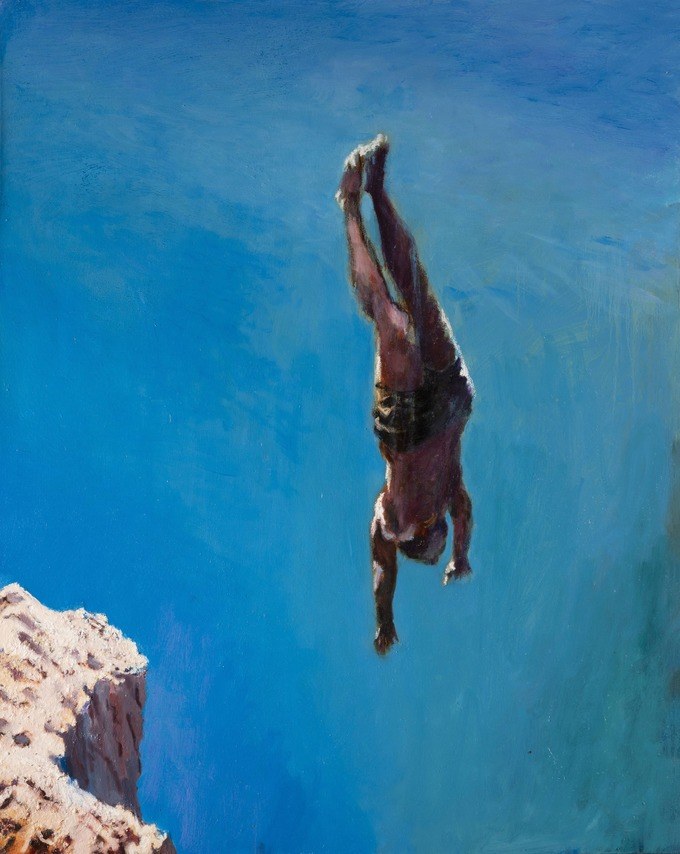Nicholas Stedman is a British artist living in Sicily. His work explores the movement, energy and temporality of the human body. Often depicting the tension between flight and falling, Nicholas sets his figures against a backdrop of abstract planes, taking them out of their context and capturing a fleeting moment.
Nicholas has been a practising artist since the 1980s, and throughout his career he has collaborated with dancers, circus artists, and divers to form his choreography of bodies in space. We caught up with Nicholas to learn about the inspiration behind his paintings on the platform.
Unison (2), 2021, by Nicholas Stedman
How would you describe the art you create?
My paintings are based on direct experience working with performers. I create figurative paintings of moving figures: divers, dancers, gymnasts or aerial artists in minimalist semi-abstract settings.
How has your practice evolved over the years?
My first figure paintings were compositions of young people moving in urban street scenes and their reflections. I introduced notions of ‘choreography’ in the placement of my figures after seeing some experimental dance improvisations by Lucinda Childs in Paris where I studied and lived for 25 years. Since then, many of my themes, such as the falling figure, have remained the same but the material aspect has changed with, for instance, the use of different types of fabric and balsa wood in my mixed media work or the breaking up of a composition into different fragments to form polyptychs.
Chaos, 2020, by Nicholas Stedman
Tell us about the ideas behind your paintings?
Movement in dance, gymnastics and other types of physical activity provide ways for people to express their inner unconscious self. The movement depicted in my figure compositions expresses temporality and the essence of life, which is energy. It plays with balance and imbalance. It is also potentially subject to interpretation by the viewer who can reverse the meaning of things, transforming the fall into momentum and vice versa.
My figures in the abstract space that constitutes the background are a message of freedom, universality and timelessness.
What/Who are your key influences?
My inspiration is mainly drawn from lived experience and the performing arts within particular dance pieces by choreographers such as Balanchine, Merce Cunningham and Trisha Brown.
Watching cliff divers jump from above at the end of the Promenade des Anglais in Nice, films like the Grand Bleu or Decouflés “Technicolor” and Merce Cunningham video dances filmed by Charles Atlas such as Locale are a few key visual experiences that have continued to inspire me.
Somersault, 2019, by Nicholas Stedman
What are the fundamental messages you want to get across with your work?
Every individual is unique and special, with their own specific characteristics through movement. In my paintings, the different moving elements come to form a single entity.
The colour in my work is a characteristic often evoked by my collectors as a carrier of a message. The dominant is essential to the chosen atmosphere and I work a lot on the nuance. The coloured note is the counterpoint of my composition.
What’s an average day like in the studio for you?
An average day’s work starts in the evening of the day before, as I like to begin in the morning knowing what I am going to do. Usually though what I do in the morning is too controlled so gradually during the day I try to let the paint answer back and stop listening too much to myself. Music helps me block out my own thoughts and immerse myself in the painting.
Tumble, 2020, by Nicholas Stedman
What's the latest project you are working on?
I’m have just finished a large composition of 4 moving figures commissioned by a collector in Hawaii. This has taken me two months with 2 spin-off works. The want to surprise myself and the passion and enthusiasm of collectors are my main motivations, and it’s very stimulating to know that someone is looking forward to receiving your work.
Diver, 2020, by Nicholas Stedman





